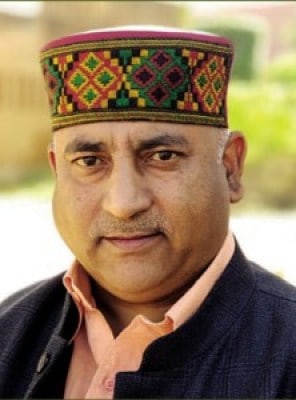 By Vishnu Makhijani
By Vishnu Makhijani
New Delhi: His keen interest in the ‘riti genre of Hindi poetry (romantic works of the 18th-20th centuries) and classical music helps him understand the nuances of Rangmala paintings that depict variations of Indian musical modes. Today, art historian and art critic Vijay Sharma is widely recognised as a fine miniature painter and has travelled extensively in India and abroad, giving lecture demonstrations on the techniques of the Pahari paintings of his native Himachal Pradesh.
“The pictorial treasure displayed in the gallery of the Bhuri Singh Museum, Chamba, had cast a considerable influence on me. The beauty and brilliance of these splendid paintings enhanced my interest in fine arts. Incidentally, most of the paintings are based on Sanskrit and Hindi poetry. The studies in Indian love-poetry helped me greatly for the proper understanding of Pahari miniature paintings,” Sharma told IANS in an interview of his latest book, “Painting In The Kangra Valley” (Niyogi Books).
“The Pahari painters rarely inscribed their works,” he explained of his research into the book, adding: “We have only sketchy information about the lives and working process of Pahari painters; hence attempts to describe their careers remain uncertain.”
“The inadequate consideration of what we know about artists’ works and stylistic developments in their milieu can lead to erroneous conclusions. Unfortunately, for want of evidence, in the case of Pahari painters, it is not possible to write on the lives and works of individual painters. In addition to the absence of any biographical information, signed Pahari works are extremely rare and dated inscriptions are almost unknown.
“The discovery of scores of centuries-old archival records containing the names and genealogies of Pahari painters retained by priests at various pilgrimage centers seemed to open up new possibilities. My tours to the places of pilgrimage yielded copious evidence related to the Pahari painters, which I have reproduced in my book,” elaborated Sharma, the recipient of several awards, including National Award of Master Craftsman in Basohli Painting in 1990 and Padma Shri in 2012. He is at present, a Senior Artist in the Bhuri Singh Museum, Chamba.
The painting activity in the region began with Kashmiri painters, who started receiving royal patronage during the reign of Raja Dalip Singh (1695-1741) of Guler. But it attained culmination during the long reign of Maharaja Sansar Chand (1776-1823) of Kangra. The royal atelier of Kangra produced a large number of paintings covering diverse subjects. The advent of the Bhakti movement in north India had a tremendous impact, resulting in a preference for Krishna themes for the artists of Guler and Kangra.
Thus, the sentiment of love is the main subject of Guler-Kangra paintings. They illustrate the finest specimens of various kinds of nayika described by the Hindi poets of the riti genre. The female figures seen in these paintings are depicted as graceful and beautiful idealisations, handled by the painters with utmost delicacy and tenderness.
Sharma’s analytical approach, based on facts, gives new insights into the origin and development of the Guler school and the marked influence of later Mughal painting on the styles of Manaku and Nainsukh. Featuring more than 160 images this book is a significant read for researchers as well as connoisseurs.
“Being myself a miniaturist, I believe that the stylistic changes that occurred in the works of Guler painters were possible only through their contacts with painters working in the Mughal style. In fact, I am convinced that Guler painters almost certainly visited centres of later Mughal painting in north India, at Delhi, Lahore or even Awadh,” he elaborated.
Noting that classical music and art of painting “were the court arts patronized by the art lover aristocrats” Sharma lamented that after Independence, “Hindustani classical music was promoted by the government by introducing it as a subject, whereas miniature painting was never given such treatment. At present, there is not a single government institution where one can learn the art of miniature painting. It is pity that Lalit Kala academy fosters only contemporary artists,” he lamented.
Sharma has co-authored several books and research articles, the notable ones being “The Temple of Devi-Kothi”; “Love for Pleasure; Vision of an Enlightened King” (ed.); “Pahari Paintings of an Ancient Romance: The Love Story of Usha-Aniruddha” and “Painted Words: Kangra Paintings of Matiram’s Rasraj”. He has also written “Kangra ki Chitrankan Parampara” (in Hindi).
What’s his next project?
“I am preparing a series of paintings on Bhagavata Purana in Guler style for the Triveni museum in Ujjain. Also, I am working on Pahari Ragamala paintings,” Sharma concluded.

